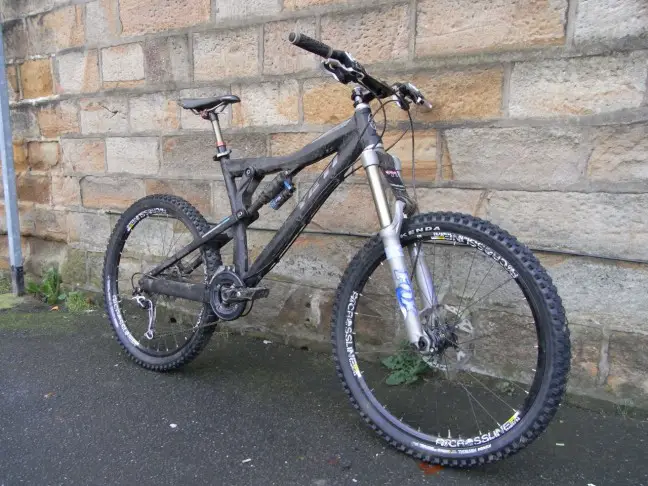
Prince: £1899 (frame only with Fox DHX Air shock)
From: Evolution Imports www.evolutionimports.co.uk
Tested: 4 weeks
It used to be that 4,5,6,7 inches of travel defined specifically what a bike was aimed at, but over the last few years we’ve been seeing these boundaries blurred somewhat. The ASR7 (Active Suspension Racing) pushes this even further by offering 7 inches of travel whilst maintaining its use as an all day trail bike, albeit a slightly bigger and heavier one. Our medium test model weighed in at 32lbs, including a Joplin seatpost. You could get it down to the 30 mark with some careful choices, the frame weighing 7.5lb. The 7 is a marginally older brother of the 575. They share the same parents, they grew up in the same household, and their family name is ASR – the 7’s the rugby playing sibling that could push you straight through a wall.
The Detail
At the head of the bike is a beefy tapered headtube, followed by some juicy welds holding onto the familiar hydroformed top tube. This top tube slopes and kinks to provide the mount for the rear shock and the large carbon swing link, as well as increase the standover height. To accommodate all this travel the seat tube curves half way along. There’s a fair bit of seatpost allowance, though the Joplin seatpost is an obvious choice. Below the curve is some nifty profiling for the E-Type front derailleur. E-Type bolts the mech onto the frame without the usual band around the seat tube. Since it’s attached around the pivot point it moves with the suspension and stays out of the way of the seatstays at full compression.
Cable routing was all fine except the front mech cable runs beneath the bottom bracket and therefore felt a bit rough due to the water and grit that inevitably finds its way in. There are also guides for a seatpost remote.
At the rear we see seatstay placed pivots with sealed bearings and a 12mm bolt through axle. The bolted axle, girder like brace on the seatstays, and that large carbon swing link make a for a noticeably stiff rear end. The only downside is a large mud platform behind the bottom bracket, though there is plenty of space for the 2.35 Kenda Nevegals that were fitted.
It looks like a very tall bike. The medium model on test measured 19in from bottom bracket to the top of seat tube. But it’s really all visually misleading, as soon as you sit on the bike it doesn’t feel as though you’re riding high. The bottom bracket, with a 1/3rd of suspension sag measures around 12.2in. It’s difficult to measure the top tube because of the sloping seatpost (68.8º quoted) but at riding height it was around 24in. Spacious would describe it.
The Ride
There was no real need for a “getting used to” transition period with the 7; it helps that we’ve spent a lot of time on Yeti 575s this year. It does feel a little higher (than a 575) but the bottom bracket is still lower than usual for something with this travel, and while it gave stability we didn’t feel a lack of ground clearance when it came to big rocks. In fact, it felt just right.
We spent quite a lot of time climbing this bike, and apart from the heft, we had no trouble. The front end felt stable, and there was none of the flip-flop steering that can happen on slacker head angles. With the Pro Pedal engaged it was happy to plod along, the suspension offering plenty of ‘dig in’ that saved us from slippage more than a few times. After dragging all this weight up the hill you need a reward, and the ASR7 certainly offered that. It wasn’t long before we were taking lines that we wouldn’t have considered previously and coming out completely unscathed. Every time we rode the bike we were happy to push it a bit further and we never really felt like we were reaching its limits. It cornered very well, even on really rocky inside lines and unbeaten track the suspension didn’t miss a beat, asking for a bit more every time.
It’s a relatively short wheelbase for something of this travel and was very maneuverable at lower speed technical stuff while staying roomy on top for your own body tweaks. The 160mm Fox FLOAT36 preformed flawlessly. A slightly shorter FLOAT32 would steepen the head angle and lighten the bike a little . We were happy enough with the 66º (on-bike) head angle. The ASR7 will work with a Fox DHX coil shock and is an option when purchasing the frame if you’re building for the downhill side of the spectrum.
Overall: Yeti have a lot to live up to and the 7 has been delayed a few times because they weren’t happy with its performance. This is the finished article and it meets its demands. It’s capable of of being ridden all day long as a burly All-Mountain bike, and it’s very fun. It is expensive, and only you know if it is a justifiable expense. If the 7 ticks the boxes for you then the 5 year warranty will also help sway you. It’s not just a 575 on stilts – it’s a 575 on steroids and all the better for it.
[stvideo src=”2010/01/Yeti_ASR7.m4v”]






